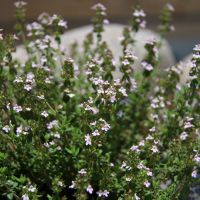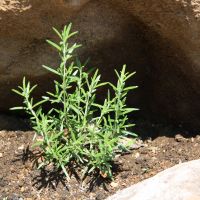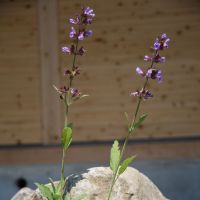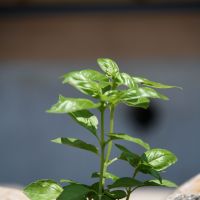"Parsley, sage, rosemary and thyme" is the refrain to one of my favorite songs, the traditional English ballad "Scarborough Fair," which was made famous when Simon and Garfunkel released it in 1966.
Though I do like folk songs, I've never been to Scarborough (in North Yorkshire), let alone to the fair. But as my favorite hobby is cooking, I am very keen on herbs and use more of them than the average cook, especially when preparing game such as venison, hare, wild boar and so on.
Herbs not only enhance the taste of food, they also help the digestion. Many books (of which I have collected quite a few) have been written on the benefits of herbs to health. Most herbs have a pleasant smell and some, such as sage and thyme, grow pretty flowers too. Sage flowers are violet-blue and about 3 cm long, and thyme has tiny blue flowers (although this herb has many varieties and colors.)
Sage and thyme grew in profusion just above the tree line about 3,000 meters up in the spectacular Simien Mountains of Ethiopia, where I served as game warden from 1968 to '70. I used them in cooking the sheep and goats I'd buy from people traveling along the mountain trails on their way to market.
I also made a fragrant tea from sage, thyme and wild jasmine to ease the occasional upset stomach I inflicted on myself by joining my rangers and imbibing kati kala, the local distillate, which is also used to light a primus stove or as a strong disinfectant. Kati kala burns with a lovely blue flame, very pretty indeed — but the devil knows what it does to brain cells, let alone stomach linings.
Wild thyme also grows in the mountains of Togakushi, just 20 minutes' drive from my place outside Kurohime in the hills of Nagano Prefecture.
Last year, our Afan Woodland Trust moved into a new center, which is raised above ground level to accommodate the snow that slides in tons off the roof in winter. The ferro-concrete base of the building is disguised by a rampart of river boulders that were washed down the local Torii River in a great flood some years ago.
The contractor who did the post-flood damage control had to remove thousands of these boulders, which he stored just about a kilometer away from the Centre — so we got our impressive rampart for nothing more than the cost of transporting the boulders and the labor it took to place them artfully and pack earth between them.
We are now turning this boulder rockery into a herb, fern and wildflower garden that will look nice and smell nice, and will also be so convenient for me to nip out of the side door of the Centre's kitchen to gather ingredients for cookery.
I have a Swedish friend here in Kurohime, Mrs. Marie Kurihara, who is an expert on growing herbs, and she willingly agreed to take charge of this rampart rockery.
So far we have planted parsley, sage, rosemary, thyme, basil, oregano, dill, fennel, black mint and wild strawberries. Purple shiso (beefsteak plant), a herb very commonly used in Japanese cooking, came in by itself, as did Japanese peppers (sanshō — the condiment most commonly used to sprinkle on braised eel).
Other "volunteers" that have arrived to make a home between the boulders include ferns, horsetails, coltsfoot and monk's hood, otherwise known as aconite, which I won't be using in my cooking unless somebody really unpleasant comes to bother me. Maybe I should pull up the monk's hood, but it does have a very pretty blue flower.
To further supplement this botanic cornucopia, Marie went into the woods to gather wild violet seeds that she will dry, cool and plant in the boulder garden later in the year. If the violets take to their new site, then they will spread — largely due to ants, which carry off their tiny seeds because they like the sweet outer coating. That's why you can often find violets growing in the most unlikely nooks and crannies.
Violet flowers are an attractive addition to salads and fruit dishes as long as you don't use too many, because they are also a medicinal plant, a diuretic and even an emetic in large doses. However, violets have been used in perfumes and for coloring drinks and syrups since ancient times.
We plan to test-plant several other herbs and wildflowers to see if they can thrive between the boulders. Although the late Emperor Hirohito is often quoted as saying, "There is no such plant as a weed," we will remove plants that we don't want, and in a few years I should be able to get nearly all my cooking herbs from the rockery and not have to go and buy them in those silly little jars they have in the supermarkets in Japan.
A marvelous range of edible and medicinal plants grows in our woods, and among my favorites, just ripe now, are the small black mountain cherries. I eat them straight off the trees, and enjoy the slightly bitter but sweet taste, which is a bit strong for some people.
However, these wild cherries — seldom used in this country except by birds and sometimes bears — make the most delicious cordial ever.
To prepare it, you put the cherries in a big jar and cover them with shōchū or awamori (Okinawan rice liquor), 30 percent alcohol being just right, and add a little of the black Okinawan sugar. Then you leave this concoction in a cool, dark place for a year.
The resulting deep-purple drink is great just as it is, or mixed in cocktails — and it makes a lovely looking refresher with soda and ice.
Handily as well, one of my medicinal herb books tells me that black cherries prevent gout, which is a rather important side effect for an old gormandizer with a penchant for venison and Guinness.
Have a nice summer!






















With your current subscription plan you can comment on stories. However, before writing your first comment, please create a display name in the Profile section of your subscriber account page.